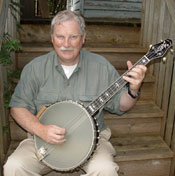Making a Banjo Bridge - by Mike Keyes

How to Make a Banjo Bridge for Tenor or Cello Banjos
I started out trying to make a better bridge for the Irish tenor banjo
which is tuned GDAE. Existing bridges have always been applied to banjo
tunings whose string diameter differences are in the range of 4:1 from
the low string to the high string. GDAE, on the other hand has a 16:1
ratio. Standard designs could not handle the tonal differences nor
could they bring out the full sound of the Irish tenor tuning.
With this in mind I took an idea from Red Henry (of RH mandolin bridge
fame) and widened the bridge to 9 cm to change the place that the sound
enters the head, made the footprint much smaller in order to focus soundbetter, and sloped and softened the sides so the bridge was player friendly. I needed a design that was easy to manufacture because I was going to try a lot of combinations of woods and I wanted others to be able to make these bridges.
The final product/design is easy to make, requires very little equipment (but is a lot easier to make with the proper equipment) and works muchbetter than most standard designs. It turns out that this design is alsouseful in cello banjos and clawhammer banjos.
A full description of my efforts and design principles is on my website
http://www.mikekeyes.com/findingtheperfectbridge
Mikes 3-part video demo on making banjo bridges:
![]()
More Articles |
Our Favorite Mike Video |
Interesting Tabs |
| Read about Mike's discovery of the Cello Banjo | Mike's Cello Banjo Critique | |
| O'Carolan Medley on Cello Banjo |
 Mike Keyes , Cello Banjo
Mike Keyes , Cello Banjo
from Fond du Lac, Wisconsin
Visit Mike's website http://www.mikekeyes.com-a.googlepages.com/irishtenorbanjo
